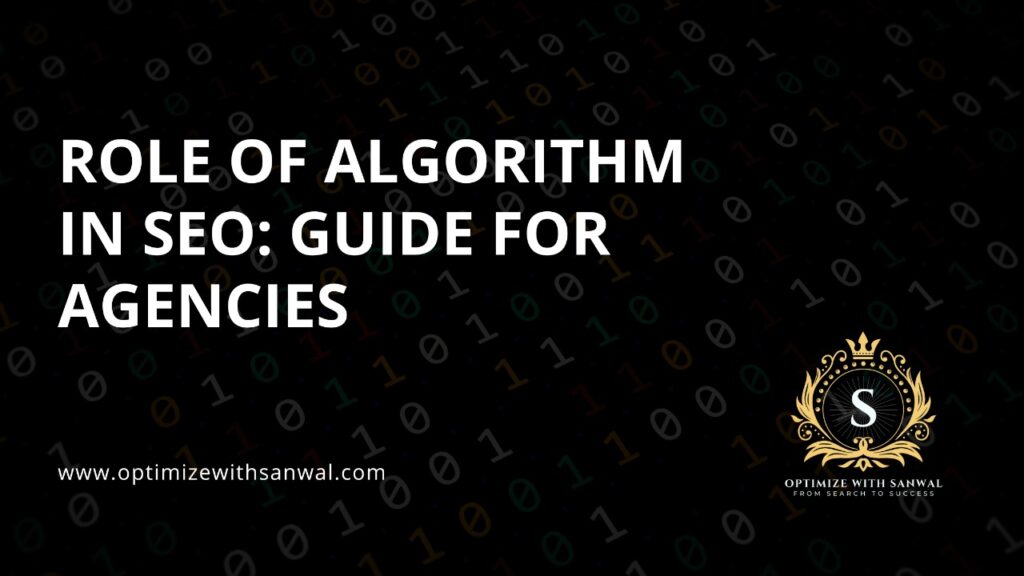Understanding the Role of Algorithms in SEO: A Beginner’s Guide
A Simple, List-Based Breakdown for Agency Owners
Introduction
For agency owners, SEO is more than a marketing channel—it’s a strategic service you offer to clients. Central to that service is an understanding of the algorithm in SEO—the set of rules and processes search engines like Google use to decide which pages rank where in search results. When Google implements a SEO algorithm update, the criteria change. As a result, sites that once ranked well may suddenly drop, while better-aligned sites rise.
This guide explains how search algorithms work, how they have evolved, and most importantly, what you and your team can do to adapt and excel. With an agency-level perspective, the aim here is to equip you with knowledge and structure to:
- Educate your team and clients on why algorithm changes matter
- Apply systematic approaches to update your existing offerings
- Stay ahead of changes and continuously improve client deliverables
Rather than using elaborate visual flourishes, this guide focuses on substance and clarity. It’s designed for agency leaders who want real depth and actionable direction.
1. What Is an Algorithm in SEO?
Defining the SEO Algorithm
At its core, an algorithm is a decision-making system—a formula used to evaluate web content. In the case of search engines, the algorithm in SEO:
- Evaluates web pages based on specific signals
- Ranks pages by relevance to a search query
- Determines which pages show up first
These signals include content quality, technical performance, backlinks, user experience, and more. The algorithm constantly updates and processes trillions of queries annually.
How Algorithms Operate
The process occurs in phases:
- Crawling and indexing: Google discovers pages and stores them in a database.
- Signal evaluation: When a query is made, Google scores available pages on hundreds of ranking factors.
- Ranking: Scores are compared; the highest-ranking pages appear at the top.
- User feedback: Signals like clicks, time on page, and bounce rate feed back into the algorithm for ongoing adjustment.
Understanding this gives agencies a clear map: it begins with technical setup, moves to content, then to links and user signals. Algorithm updates adjust each stage.
2. Why Agencies Need to Know About Search Algorithms
Corrective and Preventive Action
If an algorithm update causes drops in client visibility, your team must quickly identify whether it’s:
- Content-related
- Link-related
- Technical or performance-based
Without understanding the algorithm in SEO, patches are guesses. With it, you can diagnose precisely and respond effectively.
Communicating Strategy to Clients
Agency clients care about results—but they also value clarity. Explaining why algorithm updates matter helps you:
- Build trust
- Set realistic expectations
- Justify ongoing SEO work
When clients understand why adjustments are necessary, they’re more likely to support long-term investment.
Continuous Optimization
SEO isn’t a one-time service—it’s a cycle of assess-improve-repeat. Algorithm awareness allows your agency to treat SEO as a continuous practice, not a single deliverable.
3. Types of SEO Algorithms and Their Purposes
Understanding the different classes helps you pinpoint what to optimize after changes.
3.1 Core Ranking Algorithm
This is the main mix of signals Google uses to rank pages, updated regularly to refine relevance and quality.
3.2 Content Quality Algorithms
- Panda (2011) aimed at content farms and thin content
- Elements of Panda are still used to evaluate content quality
3.3 Backlink Algorithms
- Penguin (2012) focused on spammy backlinks
- Spam-fighting systems continue to identify unwanted linking practices
3.4 Semantic and Intent Algorithms
- Hummingbird (2013) began interpreting meaning behind queries
- RankBrain (2015) and BERT (2019) advanced understanding of intent
3.5 User Experience Metrics
- Mobile-first indexing (2018) prioritizes mobile page versions
- Core Web Vitals (2021) reflects on speed, stability, interactivity
3.6 Helpful Content and AI-Aware Updates
- Helpful Content Update (2022) penalizes low-value content
- Ongoing updates in 2023–2025 emphasize user-focused AI quality signals
As an agency, aligning deliverables to each category ensures comprehensive optimization.
4. Key SEO Algorithm Updates: A Timeline for Agencies
Knowing when Google releases major updates helps agencies plan and review.
4.1 Panda (2011)
- First major update focused on content quality
- Websites with duplicate, thin, or machine-generated content were penalized
4.2 Penguin (2012)
- Targeted manipulative backlinks and over-optimized anchor text
4.3 Hummingbird (2013)
- Shifted focus to meaning and query context, not just keyword matching
4.4 RankBrain (2015)
- Introduced machine learning to better interpret user behavior and content patterns
4.5 Mobile-First Indexing (2018)
- Google began ranking based on the mobile version of pages
4.6 Core Web Vitals (2021 Onward)
- Speed, visual stability, and interactivity became ranking criteria
4.7 Helpful Content (2022)
- Systematically flags content written primarily for search ranking
4.8 AI-Driven Relevance and UX Updates (2023–2025)
- Ongoing refinements to user experience signals, structured data cues, and real-person value
Agencies should map these milestones to changes in client performance—using them as diagnostic reference.
5. Common Signals the Algorithm Checks Regularly
Here’s a more extensive look at what the algorithm actually evaluates.
5.1 On-page Factors
- Keyword relevance and topic depth
- H1–H6 tags, meta titles/descriptions
- Structured data (schema.org markup)
- Content originality and readability
5.2 Technical Signals
- Page load speed and Core Web Vitals
- Mobile-responsiveness
- Secure browsing (HTTPS)
- Crawlability, URL structure, XML sitemaps
5.3 Off-page Signals
- Quality and relevance of backlinks
- Domain and page-level authority
- Anchor text and link diversity
5.4 User Engagement Metrics
- Bounce rate and dwell time
- Page depth per session
- Return visits and repeat traffic
5.5 Freshness and Authority
- How recent is your content?
- Does it reference current events or developments?
- Do authors have credentials or demonstrated experience?
6. How Algorithm Updates Affect Different Website Types
This section shows practical examples distinguishing how updates hit specific site types.
6.1 Service Businesses and Agencies
- Poor UX or unclear service pages lead to ranking drops
- Updates supporting structured data help local service visibility
6.2 E-commerce Sites
- Thin product descriptions now earn lower ranking
- Structured data and reviews are more influential than before
6.3 Blogs and Content Publishers
- Articles without value or real insights lose visibility
- Consistent depth, structure, and author expertise matter more
6.4 SaaS and Tools Providers
- Landing pages with vague messaging may not meet intent demands
- Users now expect clarity around features, pricing, use cases
In each case, agency deliverables—from audits to content plans—must address alignment with current algorithm priorities.
7. Five-Step Agency Framework to Adapt After an SEO Algorithm Update
7.1 Step 1: Detect Performance Shifts
- Monitor weekly trends in analytics and search console
- Note traffic, ranking, and impression declines on relevant pages
7.2 Step 2: Map Changes to Update Types
- If drop aligns with Core updates → revisit content quality
- If drop after UX update → review speed, layout, mobile usability
- If backlink drop → run link audit
This allows your agency to diagnose accurately and draft targeted fixes.
7.3 Step 3: Implement Clean Fixes
- Refresh pages with deep, user-focused updates
- Upgrade page speed, mobile responsiveness, stability
- Clean backlink profiles and add quality links
- Adjust structured data and update metadata
7.4 Step 4: Measure and Validate
- Use tools like Lighthouse, PageSpeed Insights, and analytics
- Compare before/after ranking and performance metrics
- Document improvements or areas needing iteration
7.5 Step 5: Report and Educate
- Share findings and actions in clear, brief reports
- Explain why those fixes matter in terms your clients can understand
- Position your services as responsive to algorithm trends
Rinse and repeat this process for ongoing algorithm updates.
8. Detailed Fix Strategies Per Algorithm Focus
8.1 Content Quality
- Require minimum word counts, but emphasize depth and intent satisfaction
- Encourage use of examples, visuals, data, and case studies
- Implement author bios and bylines when relevant
8.2 Technical and UX
- Audit Core Web Vitals, server response times, and image efficiency
- Clean up themes, reduce plugin bloat on CMS-based sites
- Test on mobile devices and simulate slow networks for accuracy
8.3 Structured Data
- Add schema for local businesses, products, FAQs, articles
- Validate markup periodically to prevent errors
- Align markup with subject matter
8.4 Access and Authority
- Clean unnatural backlink profiles using Disavow if needed
- Submit content to industry publishers, podcasts, or events
- Encourage client praise in the form of link-worthy content
9. How to Monitor Algorithm Updates Efficiently
9.1 Stay Informed via Reliable Sources
- Official Google Search Central blog
- SEO analysis publications (e.g., Search Engine Land, Moz, SEMrush)
- Community discussions in forums such as WebmasterWorld or SEO subreddit
9.2 Use Tools to Identify Impact
- Rank tracking tools (SEMrush, Ahrefs, Moz) to highlight keyword flux
- Analytics sets to spot traffic dips correlating to updates
- Site audit tools for depth, structure, and performance issues
9.3 Establish Baseline Metrics
Maintain baseline documentation:
- Traffic and ranking trends per page
- Core Web Vitals scores
- Backlink quantity and quality
That way, after an update, deviation becomes clearly identifiable—and actions become easier to justify.
10. Why Algorithm Knowledge Is a Competitive Advantage
Agencies that respond quickly and accurately stand out from competitors who wait passively. You can:
- Offer targeted, intelligent SEO improvements
- Reduce downtime, recovery cycles, and client concerns
- Elevate your reputation as a proactive, knowledgeable partner
Clients pay for expertise—and understanding the algorithm gives you leverage to add value at every opportunity.
Conclusion
Search algorithms no longer operate predictably. They are complex systems with hundreds of signals, constantly evolving to surface the most relevant, reliable, and user-focused content. As an agency owner, building your service delivery around that evolving structure—broken into diagnosable, fixable areas—puts you in control.
You don’t need to react chaotically after every update. Instead, use this framework: detect change, diagnose impact, implement fixes, validate results, and educate clients. That approach doesn’t just reflect algorithmic understanding—it demonstrates professional maturity and long-term service optimization.
When you’re ready to convert knowledge into real growth, book a strategy call. OptimizeWithSanwal is here to help you with our seo services to lead your clients to better rankings, consistent visibility, and stronger online presence.
Call to Action
Understanding the algorithm is fundamental. But what matters most is what you do with that knowledge. When you’re ready to turn insight into action:
Book a strategy call with OptimizeWithSanwal. We’ll review your current site performance, highlight areas affected by recent algorithm changes, and craft a practical roadmap to improve rankings and visibility.

